Organisational Structures, Functions, and Environment: M&S Report
VerifiedAdded on 2023/01/19
|17
|5551
|60
Report
AI Summary
This report provides a comprehensive analysis of diverse organizational types, including public, private, and voluntary organizations, with a focus on Marks & Spencer. It explores their purposes, legal structures, size, and scope, highlighting the differences between them. The report delves into the relationships between various organizational functions such as HR, finance, marketing, and production, and how they link to the overall objectives and structure of a business. Furthermore, it examines the impact of the external macro environment on business operations, including internal and external business analysis, and the interrelation between strengths, weaknesses, and the macro environment. The report concludes with an overview of the key findings and references supporting the analysis.
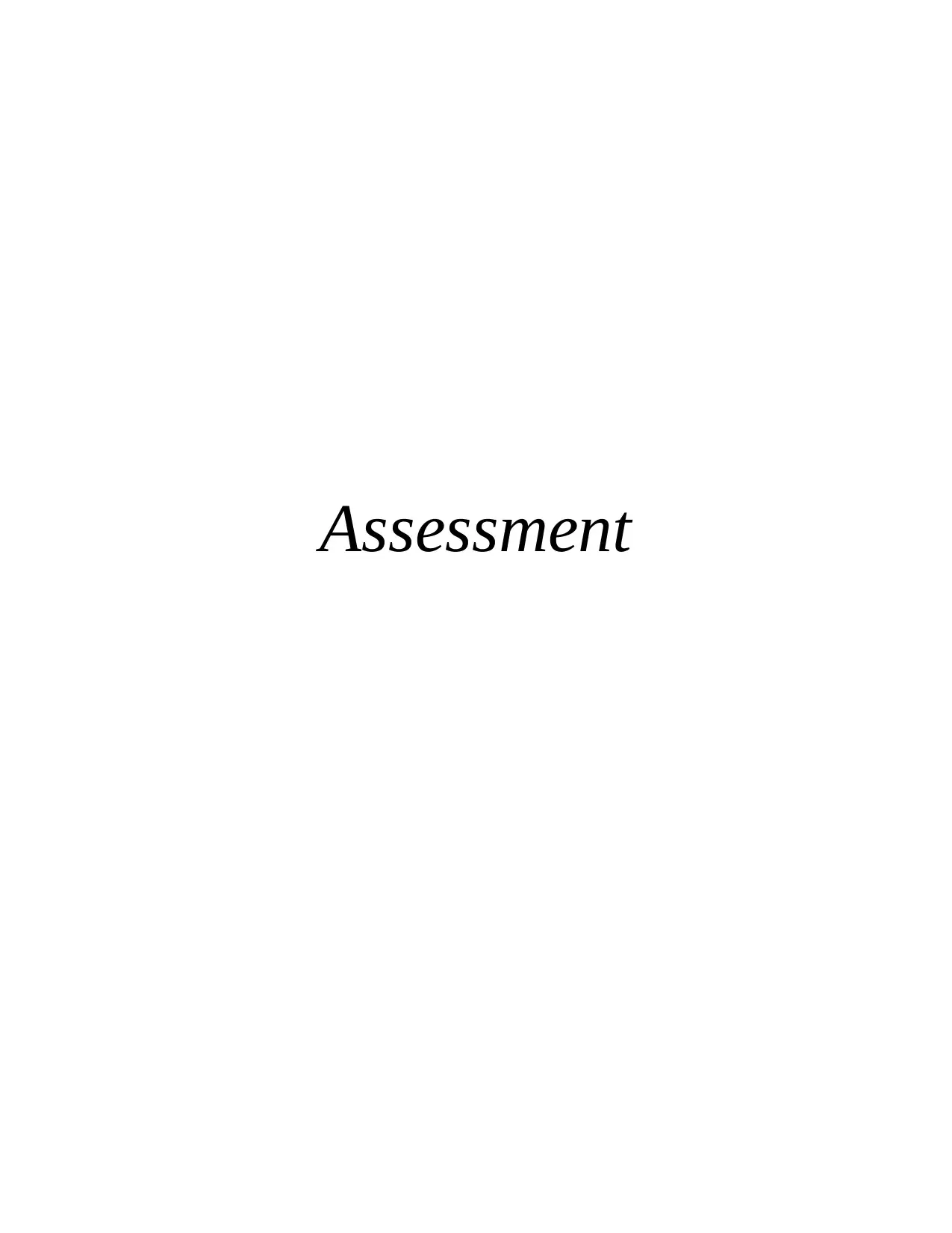
Assessment
Paraphrase This Document
Need a fresh take? Get an instant paraphrase of this document with our AI Paraphraser
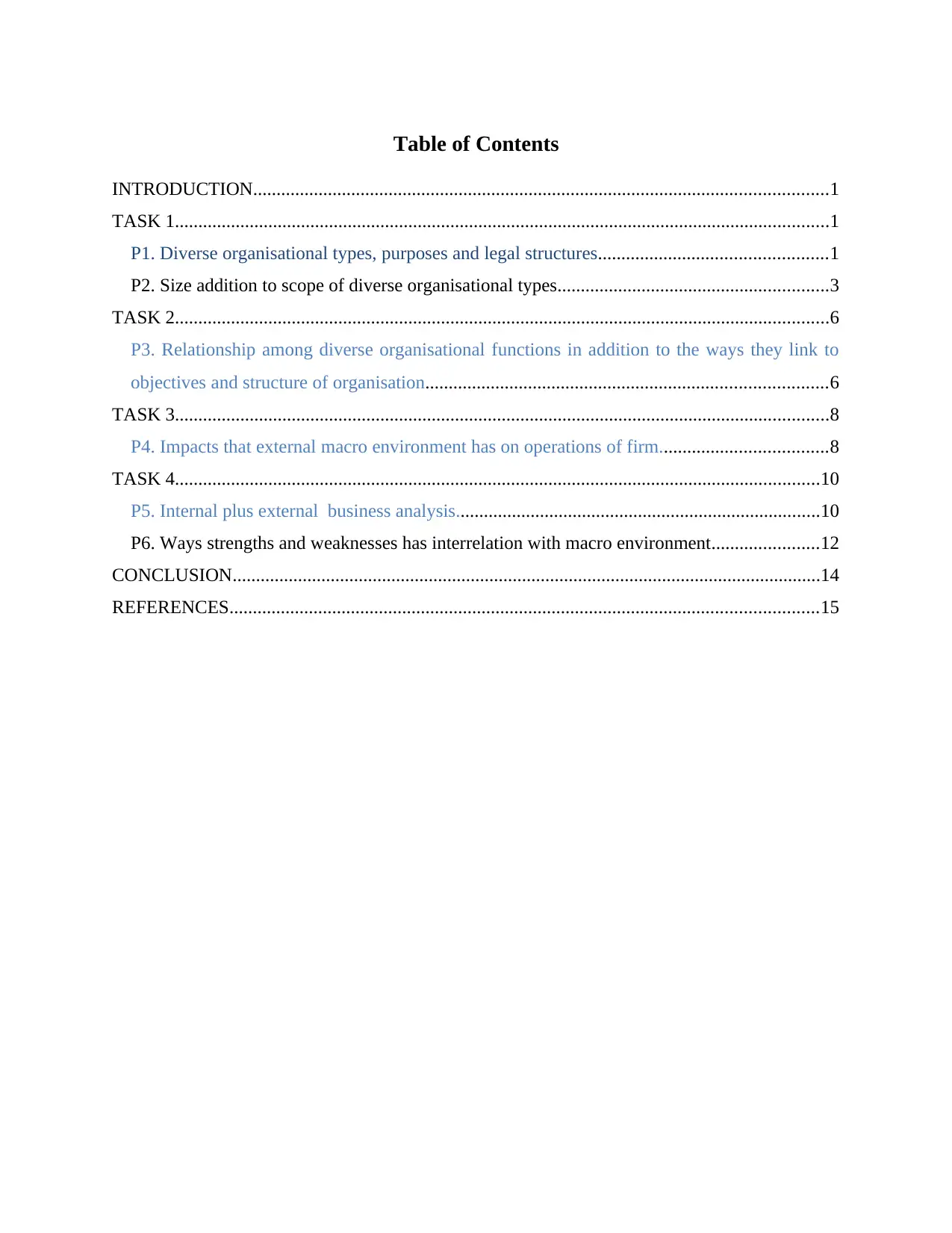
Table of Contents
INTRODUCTION...........................................................................................................................1
TASK 1............................................................................................................................................1
P1. Diverse organisational types, purposes and legal structures.................................................1
P2. Size addition to scope of diverse organisational types..........................................................3
TASK 2............................................................................................................................................6
P3. Relationship among diverse organisational functions in addition to the ways they link to
objectives and structure of organisation......................................................................................6
TASK 3............................................................................................................................................8
P4. Impacts that external macro environment has on operations of firm....................................8
TASK 4..........................................................................................................................................10
P5. Internal plus external business analysis..............................................................................10
P6. Ways strengths and weaknesses has interrelation with macro environment.......................12
CONCLUSION..............................................................................................................................14
REFERENCES..............................................................................................................................15
INTRODUCTION...........................................................................................................................1
TASK 1............................................................................................................................................1
P1. Diverse organisational types, purposes and legal structures.................................................1
P2. Size addition to scope of diverse organisational types..........................................................3
TASK 2............................................................................................................................................6
P3. Relationship among diverse organisational functions in addition to the ways they link to
objectives and structure of organisation......................................................................................6
TASK 3............................................................................................................................................8
P4. Impacts that external macro environment has on operations of firm....................................8
TASK 4..........................................................................................................................................10
P5. Internal plus external business analysis..............................................................................10
P6. Ways strengths and weaknesses has interrelation with macro environment.......................12
CONCLUSION..............................................................................................................................14
REFERENCES..............................................................................................................................15
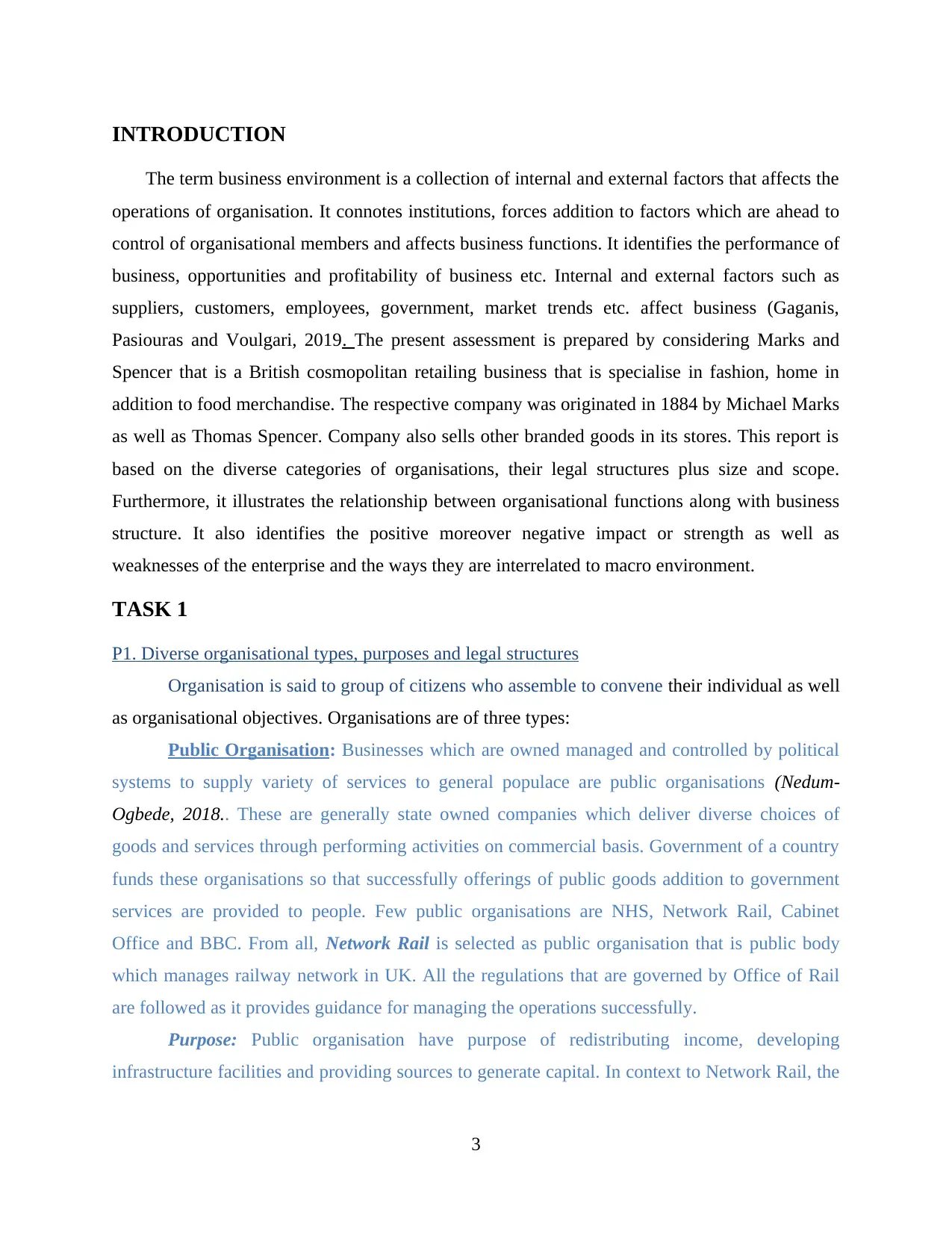
INTRODUCTION
The term business environment is a collection of internal and external factors that affects the
operations of organisation. It connotes institutions, forces addition to factors which are ahead to
control of organisational members and affects business functions. It identifies the performance of
business, opportunities and profitability of business etc. Internal and external factors such as
suppliers, customers, employees, government, market trends etc. affect business (Gaganis,
Pasiouras and Voulgari, 2019. The present assessment is prepared by considering Marks and
Spencer that is a British cosmopolitan retailing business that is specialise in fashion, home in
addition to food merchandise. The respective company was originated in 1884 by Michael Marks
as well as Thomas Spencer. Company also sells other branded goods in its stores. This report is
based on the diverse categories of organisations, their legal structures plus size and scope.
Furthermore, it illustrates the relationship between organisational functions along with business
structure. It also identifies the positive moreover negative impact or strength as well as
weaknesses of the enterprise and the ways they are interrelated to macro environment.
TASK 1
P1. Diverse organisational types, purposes and legal structures
Organisation is said to group of citizens who assemble to convene their individual as well
as organisational objectives. Organisations are of three types:
Public Organisation: Businesses which are owned managed and controlled by political
systems to supply variety of services to general populace are public organisations (Nedum-
Ogbede, 2018.. These are generally state owned companies which deliver diverse choices of
goods and services through performing activities on commercial basis. Government of a country
funds these organisations so that successfully offerings of public goods addition to government
services are provided to people. Few public organisations are NHS, Network Rail, Cabinet
Office and BBC. From all, Network Rail is selected as public organisation that is public body
which manages railway network in UK. All the regulations that are governed by Office of Rail
are followed as it provides guidance for managing the operations successfully.
Purpose: Public organisation have purpose of redistributing income, developing
infrastructure facilities and providing sources to generate capital. In context to Network Rail, the
3
The term business environment is a collection of internal and external factors that affects the
operations of organisation. It connotes institutions, forces addition to factors which are ahead to
control of organisational members and affects business functions. It identifies the performance of
business, opportunities and profitability of business etc. Internal and external factors such as
suppliers, customers, employees, government, market trends etc. affect business (Gaganis,
Pasiouras and Voulgari, 2019. The present assessment is prepared by considering Marks and
Spencer that is a British cosmopolitan retailing business that is specialise in fashion, home in
addition to food merchandise. The respective company was originated in 1884 by Michael Marks
as well as Thomas Spencer. Company also sells other branded goods in its stores. This report is
based on the diverse categories of organisations, their legal structures plus size and scope.
Furthermore, it illustrates the relationship between organisational functions along with business
structure. It also identifies the positive moreover negative impact or strength as well as
weaknesses of the enterprise and the ways they are interrelated to macro environment.
TASK 1
P1. Diverse organisational types, purposes and legal structures
Organisation is said to group of citizens who assemble to convene their individual as well
as organisational objectives. Organisations are of three types:
Public Organisation: Businesses which are owned managed and controlled by political
systems to supply variety of services to general populace are public organisations (Nedum-
Ogbede, 2018.. These are generally state owned companies which deliver diverse choices of
goods and services through performing activities on commercial basis. Government of a country
funds these organisations so that successfully offerings of public goods addition to government
services are provided to people. Few public organisations are NHS, Network Rail, Cabinet
Office and BBC. From all, Network Rail is selected as public organisation that is public body
which manages railway network in UK. All the regulations that are governed by Office of Rail
are followed as it provides guidance for managing the operations successfully.
Purpose: Public organisation have purpose of redistributing income, developing
infrastructure facilities and providing sources to generate capital. In context to Network Rail, the
3
⊘ This is a preview!⊘
Do you want full access?
Subscribe today to unlock all pages.

Trusted by 1+ million students worldwide
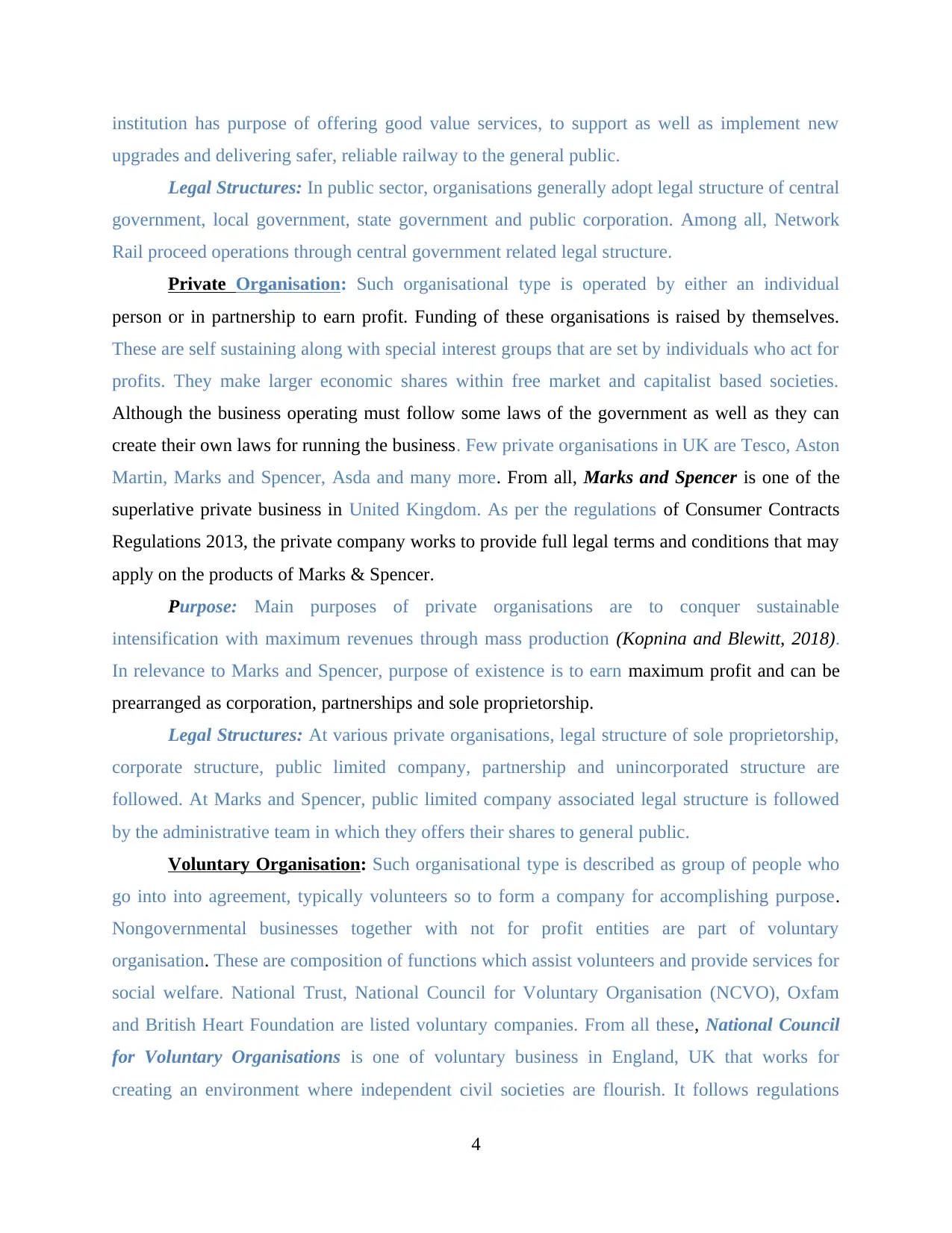
institution has purpose of offering good value services, to support as well as implement new
upgrades and delivering safer, reliable railway to the general public.
Legal Structures: In public sector, organisations generally adopt legal structure of central
government, local government, state government and public corporation. Among all, Network
Rail proceed operations through central government related legal structure.
Private Organisation: Such organisational type is operated by either an individual
person or in partnership to earn profit. Funding of these organisations is raised by themselves.
These are self sustaining along with special interest groups that are set by individuals who act for
profits. They make larger economic shares within free market and capitalist based societies.
Although the business operating must follow some laws of the government as well as they can
create their own laws for running the business. Few private organisations in UK are Tesco, Aston
Martin, Marks and Spencer, Asda and many more. From all, Marks and Spencer is one of the
superlative private business in United Kingdom. As per the regulations of Consumer Contracts
Regulations 2013, the private company works to provide full legal terms and conditions that may
apply on the products of Marks & Spencer.
Purpose: Main purposes of private organisations are to conquer sustainable
intensification with maximum revenues through mass production (Kopnina and Blewitt, 2018).
In relevance to Marks and Spencer, purpose of existence is to earn maximum profit and can be
prearranged as corporation, partnerships and sole proprietorship.
Legal Structures: At various private organisations, legal structure of sole proprietorship,
corporate structure, public limited company, partnership and unincorporated structure are
followed. At Marks and Spencer, public limited company associated legal structure is followed
by the administrative team in which they offers their shares to general public.
Voluntary Organisation: Such organisational type is described as group of people who
go into into agreement, typically volunteers so to form a company for accomplishing purpose.
Nongovernmental businesses together with not for profit entities are part of voluntary
organisation. These are composition of functions which assist volunteers and provide services for
social welfare. National Trust, National Council for Voluntary Organisation (NCVO), Oxfam
and British Heart Foundation are listed voluntary companies. From all these, National Council
for Voluntary Organisations is one of voluntary business in England, UK that works for
creating an environment where independent civil societies are flourish. It follows regulations
4
upgrades and delivering safer, reliable railway to the general public.
Legal Structures: In public sector, organisations generally adopt legal structure of central
government, local government, state government and public corporation. Among all, Network
Rail proceed operations through central government related legal structure.
Private Organisation: Such organisational type is operated by either an individual
person or in partnership to earn profit. Funding of these organisations is raised by themselves.
These are self sustaining along with special interest groups that are set by individuals who act for
profits. They make larger economic shares within free market and capitalist based societies.
Although the business operating must follow some laws of the government as well as they can
create their own laws for running the business. Few private organisations in UK are Tesco, Aston
Martin, Marks and Spencer, Asda and many more. From all, Marks and Spencer is one of the
superlative private business in United Kingdom. As per the regulations of Consumer Contracts
Regulations 2013, the private company works to provide full legal terms and conditions that may
apply on the products of Marks & Spencer.
Purpose: Main purposes of private organisations are to conquer sustainable
intensification with maximum revenues through mass production (Kopnina and Blewitt, 2018).
In relevance to Marks and Spencer, purpose of existence is to earn maximum profit and can be
prearranged as corporation, partnerships and sole proprietorship.
Legal Structures: At various private organisations, legal structure of sole proprietorship,
corporate structure, public limited company, partnership and unincorporated structure are
followed. At Marks and Spencer, public limited company associated legal structure is followed
by the administrative team in which they offers their shares to general public.
Voluntary Organisation: Such organisational type is described as group of people who
go into into agreement, typically volunteers so to form a company for accomplishing purpose.
Nongovernmental businesses together with not for profit entities are part of voluntary
organisation. These are composition of functions which assist volunteers and provide services for
social welfare. National Trust, National Council for Voluntary Organisation (NCVO), Oxfam
and British Heart Foundation are listed voluntary companies. From all these, National Council
for Voluntary Organisations is one of voluntary business in England, UK that works for
creating an environment where independent civil societies are flourish. It follows regulations
4
Paraphrase This Document
Need a fresh take? Get an instant paraphrase of this document with our AI Paraphraser
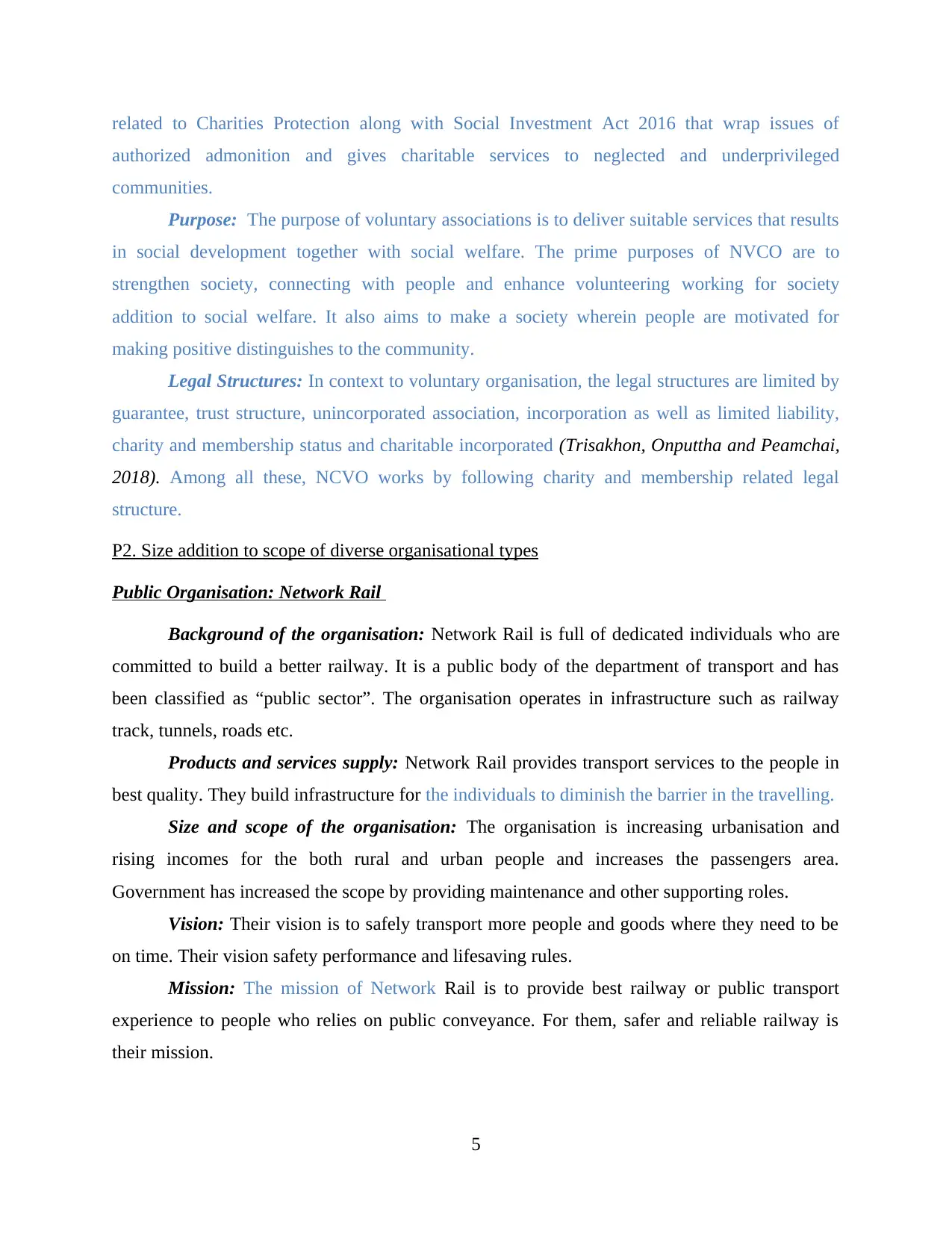
related to Charities Protection along with Social Investment Act 2016 that wrap issues of
authorized admonition and gives charitable services to neglected and underprivileged
communities.
Purpose: The purpose of voluntary associations is to deliver suitable services that results
in social development together with social welfare. The prime purposes of NVCO are to
strengthen society, connecting with people and enhance volunteering working for society
addition to social welfare. It also aims to make a society wherein people are motivated for
making positive distinguishes to the community.
Legal Structures: In context to voluntary organisation, the legal structures are limited by
guarantee, trust structure, unincorporated association, incorporation as well as limited liability,
charity and membership status and charitable incorporated (Trisakhon, Onputtha and Peamchai,
2018). Among all these, NCVO works by following charity and membership related legal
structure.
P2. Size addition to scope of diverse organisational types
Public Organisation: Network Rail
Background of the organisation: Network Rail is full of dedicated individuals who are
committed to build a better railway. It is a public body of the department of transport and has
been classified as “public sector”. The organisation operates in infrastructure such as railway
track, tunnels, roads etc.
Products and services supply: Network Rail provides transport services to the people in
best quality. They build infrastructure for the individuals to diminish the barrier in the travelling.
Size and scope of the organisation: The organisation is increasing urbanisation and
rising incomes for the both rural and urban people and increases the passengers area.
Government has increased the scope by providing maintenance and other supporting roles.
Vision: Their vision is to safely transport more people and goods where they need to be
on time. Their vision safety performance and lifesaving rules.
Mission: The mission of Network Rail is to provide best railway or public transport
experience to people who relies on public conveyance. For them, safer and reliable railway is
their mission.
5
authorized admonition and gives charitable services to neglected and underprivileged
communities.
Purpose: The purpose of voluntary associations is to deliver suitable services that results
in social development together with social welfare. The prime purposes of NVCO are to
strengthen society, connecting with people and enhance volunteering working for society
addition to social welfare. It also aims to make a society wherein people are motivated for
making positive distinguishes to the community.
Legal Structures: In context to voluntary organisation, the legal structures are limited by
guarantee, trust structure, unincorporated association, incorporation as well as limited liability,
charity and membership status and charitable incorporated (Trisakhon, Onputtha and Peamchai,
2018). Among all these, NCVO works by following charity and membership related legal
structure.
P2. Size addition to scope of diverse organisational types
Public Organisation: Network Rail
Background of the organisation: Network Rail is full of dedicated individuals who are
committed to build a better railway. It is a public body of the department of transport and has
been classified as “public sector”. The organisation operates in infrastructure such as railway
track, tunnels, roads etc.
Products and services supply: Network Rail provides transport services to the people in
best quality. They build infrastructure for the individuals to diminish the barrier in the travelling.
Size and scope of the organisation: The organisation is increasing urbanisation and
rising incomes for the both rural and urban people and increases the passengers area.
Government has increased the scope by providing maintenance and other supporting roles.
Vision: Their vision is to safely transport more people and goods where they need to be
on time. Their vision safety performance and lifesaving rules.
Mission: The mission of Network Rail is to provide best railway or public transport
experience to people who relies on public conveyance. For them, safer and reliable railway is
their mission.
5
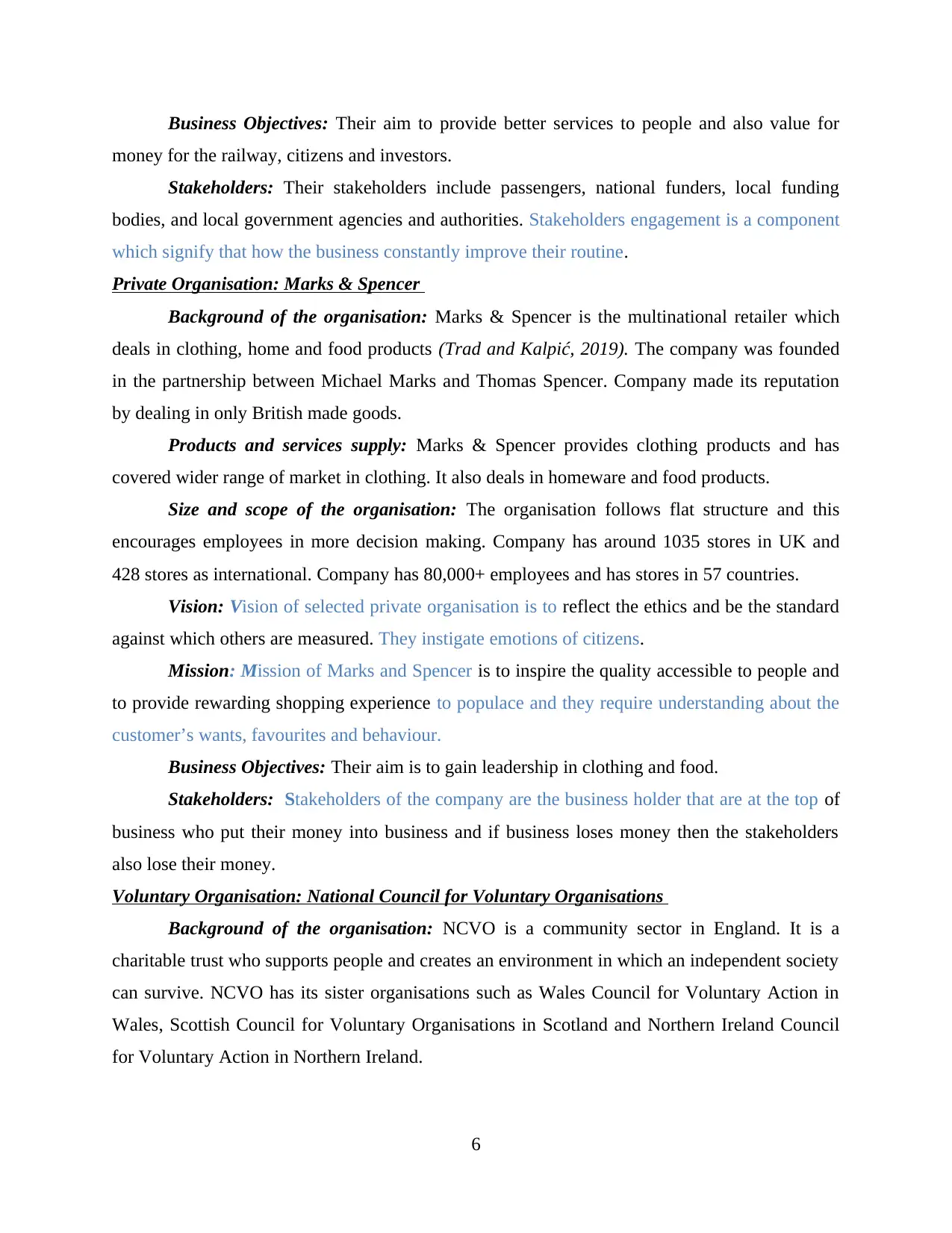
Business Objectives: Their aim to provide better services to people and also value for
money for the railway, citizens and investors.
Stakeholders: Their stakeholders include passengers, national funders, local funding
bodies, and local government agencies and authorities. Stakeholders engagement is a component
which signify that how the business constantly improve their routine.
Private Organisation: Marks & Spencer
Background of the organisation: Marks & Spencer is the multinational retailer which
deals in clothing, home and food products (Trad and Kalpić, 2019). The company was founded
in the partnership between Michael Marks and Thomas Spencer. Company made its reputation
by dealing in only British made goods.
Products and services supply: Marks & Spencer provides clothing products and has
covered wider range of market in clothing. It also deals in homeware and food products.
Size and scope of the organisation: The organisation follows flat structure and this
encourages employees in more decision making. Company has around 1035 stores in UK and
428 stores as international. Company has 80,000+ employees and has stores in 57 countries.
Vision: Vision of selected private organisation is to reflect the ethics and be the standard
against which others are measured. They instigate emotions of citizens.
Mission: Mission of Marks and Spencer is to inspire the quality accessible to people and
to provide rewarding shopping experience to populace and they require understanding about the
customer’s wants, favourites and behaviour.
Business Objectives: Their aim is to gain leadership in clothing and food.
Stakeholders: Stakeholders of the company are the business holder that are at the top of
business who put their money into business and if business loses money then the stakeholders
also lose their money.
Voluntary Organisation: National Council for Voluntary Organisations
Background of the organisation: NCVO is a community sector in England. It is a
charitable trust who supports people and creates an environment in which an independent society
can survive. NCVO has its sister organisations such as Wales Council for Voluntary Action in
Wales, Scottish Council for Voluntary Organisations in Scotland and Northern Ireland Council
for Voluntary Action in Northern Ireland.
6
money for the railway, citizens and investors.
Stakeholders: Their stakeholders include passengers, national funders, local funding
bodies, and local government agencies and authorities. Stakeholders engagement is a component
which signify that how the business constantly improve their routine.
Private Organisation: Marks & Spencer
Background of the organisation: Marks & Spencer is the multinational retailer which
deals in clothing, home and food products (Trad and Kalpić, 2019). The company was founded
in the partnership between Michael Marks and Thomas Spencer. Company made its reputation
by dealing in only British made goods.
Products and services supply: Marks & Spencer provides clothing products and has
covered wider range of market in clothing. It also deals in homeware and food products.
Size and scope of the organisation: The organisation follows flat structure and this
encourages employees in more decision making. Company has around 1035 stores in UK and
428 stores as international. Company has 80,000+ employees and has stores in 57 countries.
Vision: Vision of selected private organisation is to reflect the ethics and be the standard
against which others are measured. They instigate emotions of citizens.
Mission: Mission of Marks and Spencer is to inspire the quality accessible to people and
to provide rewarding shopping experience to populace and they require understanding about the
customer’s wants, favourites and behaviour.
Business Objectives: Their aim is to gain leadership in clothing and food.
Stakeholders: Stakeholders of the company are the business holder that are at the top of
business who put their money into business and if business loses money then the stakeholders
also lose their money.
Voluntary Organisation: National Council for Voluntary Organisations
Background of the organisation: NCVO is a community sector in England. It is a
charitable trust who supports people and creates an environment in which an independent society
can survive. NCVO has its sister organisations such as Wales Council for Voluntary Action in
Wales, Scottish Council for Voluntary Organisations in Scotland and Northern Ireland Council
for Voluntary Action in Northern Ireland.
6
⊘ This is a preview!⊘
Do you want full access?
Subscribe today to unlock all pages.

Trusted by 1+ million students worldwide
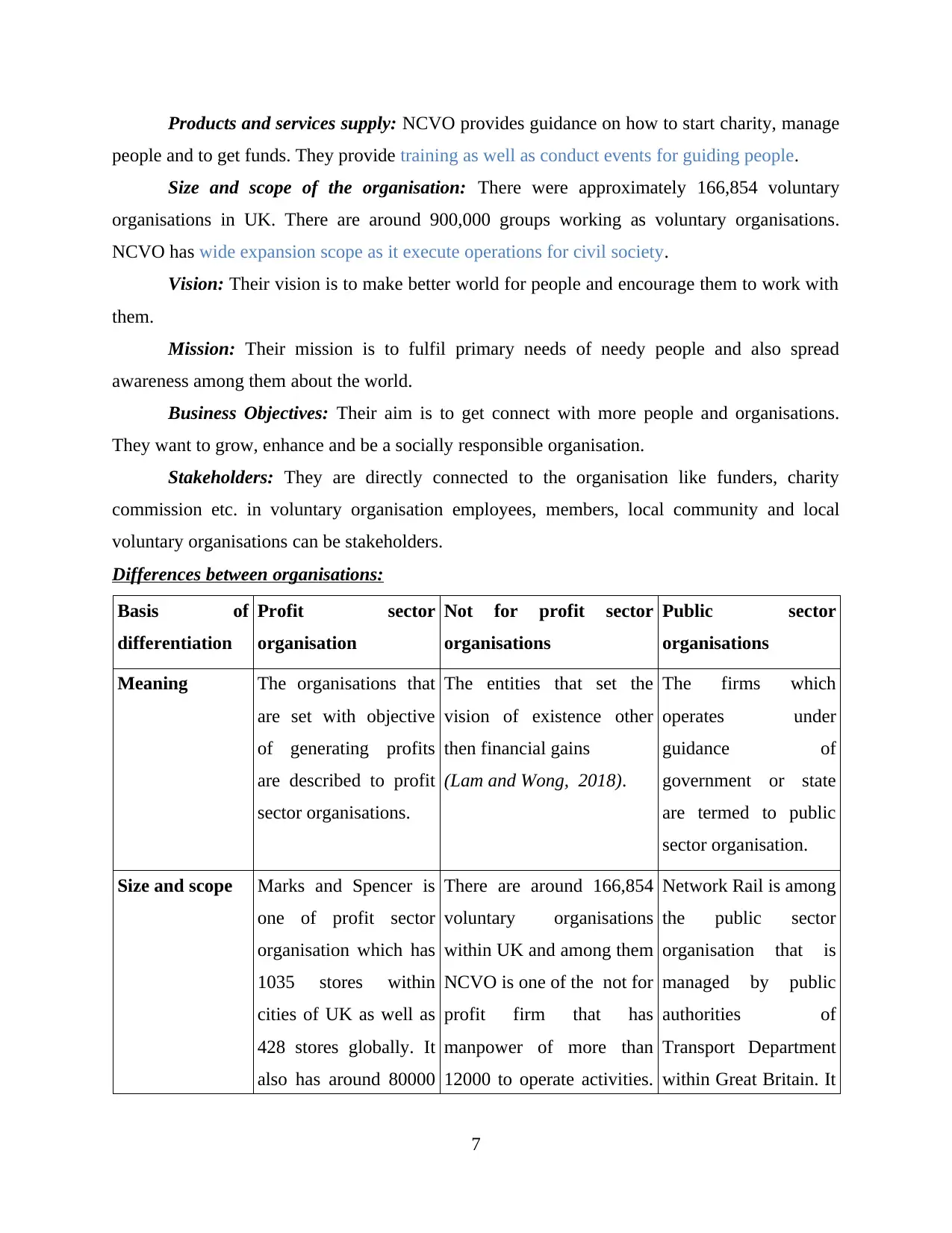
Products and services supply: NCVO provides guidance on how to start charity, manage
people and to get funds. They provide training as well as conduct events for guiding people.
Size and scope of the organisation: There were approximately 166,854 voluntary
organisations in UK. There are around 900,000 groups working as voluntary organisations.
NCVO has wide expansion scope as it execute operations for civil society.
Vision: Their vision is to make better world for people and encourage them to work with
them.
Mission: Their mission is to fulfil primary needs of needy people and also spread
awareness among them about the world.
Business Objectives: Their aim is to get connect with more people and organisations.
They want to grow, enhance and be a socially responsible organisation.
Stakeholders: They are directly connected to the organisation like funders, charity
commission etc. in voluntary organisation employees, members, local community and local
voluntary organisations can be stakeholders.
Differences between organisations:
Basis of
differentiation
Profit sector
organisation
Not for profit sector
organisations
Public sector
organisations
Meaning The organisations that
are set with objective
of generating profits
are described to profit
sector organisations.
The entities that set the
vision of existence other
then financial gains
(Lam and Wong, 2018).
The firms which
operates under
guidance of
government or state
are termed to public
sector organisation.
Size and scope Marks and Spencer is
one of profit sector
organisation which has
1035 stores within
cities of UK as well as
428 stores globally. It
also has around 80000
There are around 166,854
voluntary organisations
within UK and among them
NCVO is one of the not for
profit firm that has
manpower of more than
12000 to operate activities.
Network Rail is among
the public sector
organisation that is
managed by public
authorities of
Transport Department
within Great Britain. It
7
people and to get funds. They provide training as well as conduct events for guiding people.
Size and scope of the organisation: There were approximately 166,854 voluntary
organisations in UK. There are around 900,000 groups working as voluntary organisations.
NCVO has wide expansion scope as it execute operations for civil society.
Vision: Their vision is to make better world for people and encourage them to work with
them.
Mission: Their mission is to fulfil primary needs of needy people and also spread
awareness among them about the world.
Business Objectives: Their aim is to get connect with more people and organisations.
They want to grow, enhance and be a socially responsible organisation.
Stakeholders: They are directly connected to the organisation like funders, charity
commission etc. in voluntary organisation employees, members, local community and local
voluntary organisations can be stakeholders.
Differences between organisations:
Basis of
differentiation
Profit sector
organisation
Not for profit sector
organisations
Public sector
organisations
Meaning The organisations that
are set with objective
of generating profits
are described to profit
sector organisations.
The entities that set the
vision of existence other
then financial gains
(Lam and Wong, 2018).
The firms which
operates under
guidance of
government or state
are termed to public
sector organisation.
Size and scope Marks and Spencer is
one of profit sector
organisation which has
1035 stores within
cities of UK as well as
428 stores globally. It
also has around 80000
There are around 166,854
voluntary organisations
within UK and among them
NCVO is one of the not for
profit firm that has
manpower of more than
12000 to operate activities.
Network Rail is among
the public sector
organisation that is
managed by public
authorities of
Transport Department
within Great Britain. It
7
Paraphrase This Document
Need a fresh take? Get an instant paraphrase of this document with our AI Paraphraser
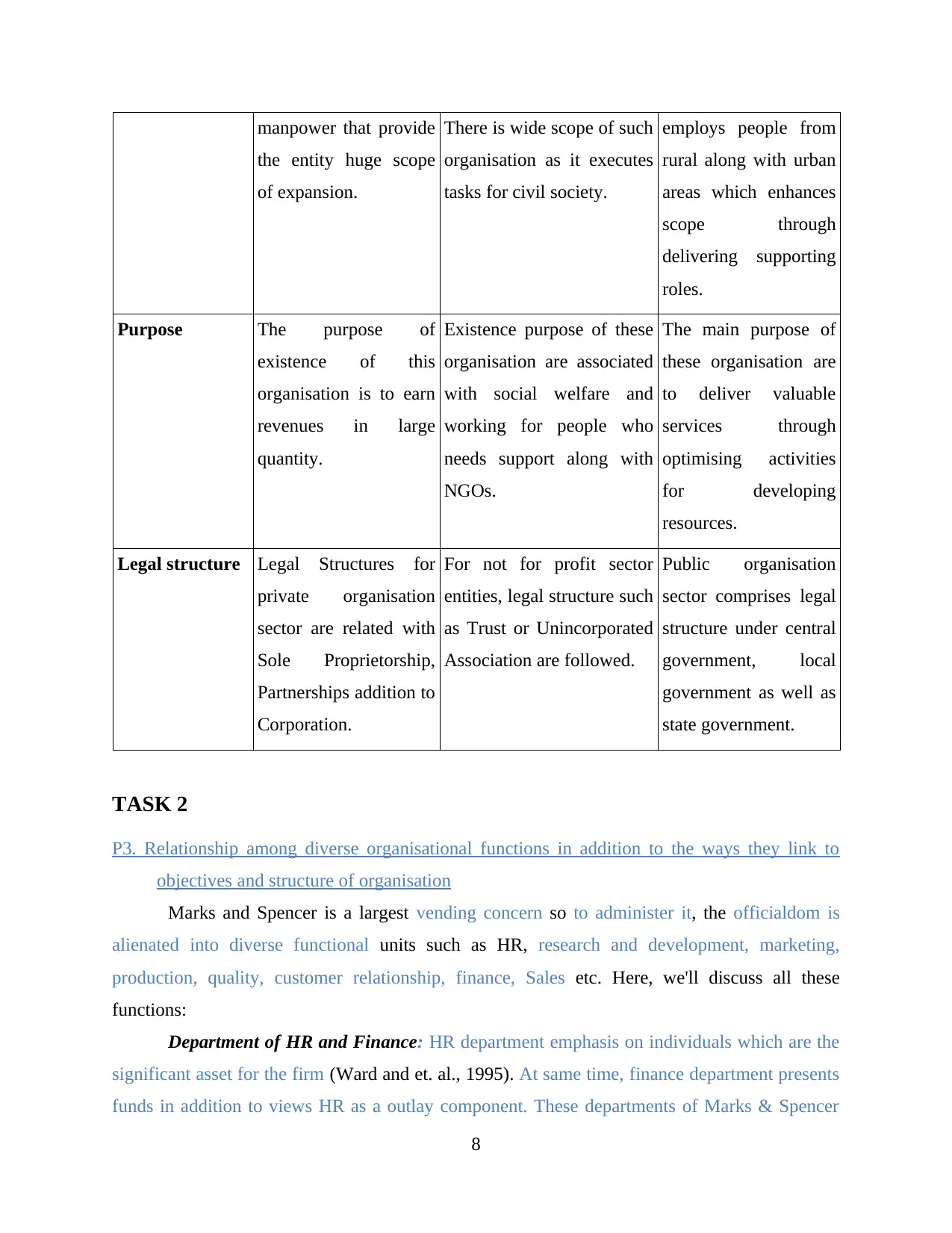
manpower that provide
the entity huge scope
of expansion.
There is wide scope of such
organisation as it executes
tasks for civil society.
employs people from
rural along with urban
areas which enhances
scope through
delivering supporting
roles.
Purpose The purpose of
existence of this
organisation is to earn
revenues in large
quantity.
Existence purpose of these
organisation are associated
with social welfare and
working for people who
needs support along with
NGOs.
The main purpose of
these organisation are
to deliver valuable
services through
optimising activities
for developing
resources.
Legal structure Legal Structures for
private organisation
sector are related with
Sole Proprietorship,
Partnerships addition to
Corporation.
For not for profit sector
entities, legal structure such
as Trust or Unincorporated
Association are followed.
Public organisation
sector comprises legal
structure under central
government, local
government as well as
state government.
TASK 2
P3. Relationship among diverse organisational functions in addition to the ways they link to
objectives and structure of organisation
Marks and Spencer is a largest vending concern so to administer it, the officialdom is
alienated into diverse functional units such as HR, research and development, marketing,
production, quality, customer relationship, finance, Sales etc. Here, we'll discuss all these
functions:
Department of HR and Finance: HR department emphasis on individuals which are the
significant asset for the firm (Ward and et. al., 1995). At same time, finance department presents
funds in addition to views HR as a outlay component. These departments of Marks & Spencer
8
the entity huge scope
of expansion.
There is wide scope of such
organisation as it executes
tasks for civil society.
employs people from
rural along with urban
areas which enhances
scope through
delivering supporting
roles.
Purpose The purpose of
existence of this
organisation is to earn
revenues in large
quantity.
Existence purpose of these
organisation are associated
with social welfare and
working for people who
needs support along with
NGOs.
The main purpose of
these organisation are
to deliver valuable
services through
optimising activities
for developing
resources.
Legal structure Legal Structures for
private organisation
sector are related with
Sole Proprietorship,
Partnerships addition to
Corporation.
For not for profit sector
entities, legal structure such
as Trust or Unincorporated
Association are followed.
Public organisation
sector comprises legal
structure under central
government, local
government as well as
state government.
TASK 2
P3. Relationship among diverse organisational functions in addition to the ways they link to
objectives and structure of organisation
Marks and Spencer is a largest vending concern so to administer it, the officialdom is
alienated into diverse functional units such as HR, research and development, marketing,
production, quality, customer relationship, finance, Sales etc. Here, we'll discuss all these
functions:
Department of HR and Finance: HR department emphasis on individuals which are the
significant asset for the firm (Ward and et. al., 1995). At same time, finance department presents
funds in addition to views HR as a outlay component. These departments of Marks & Spencer
8
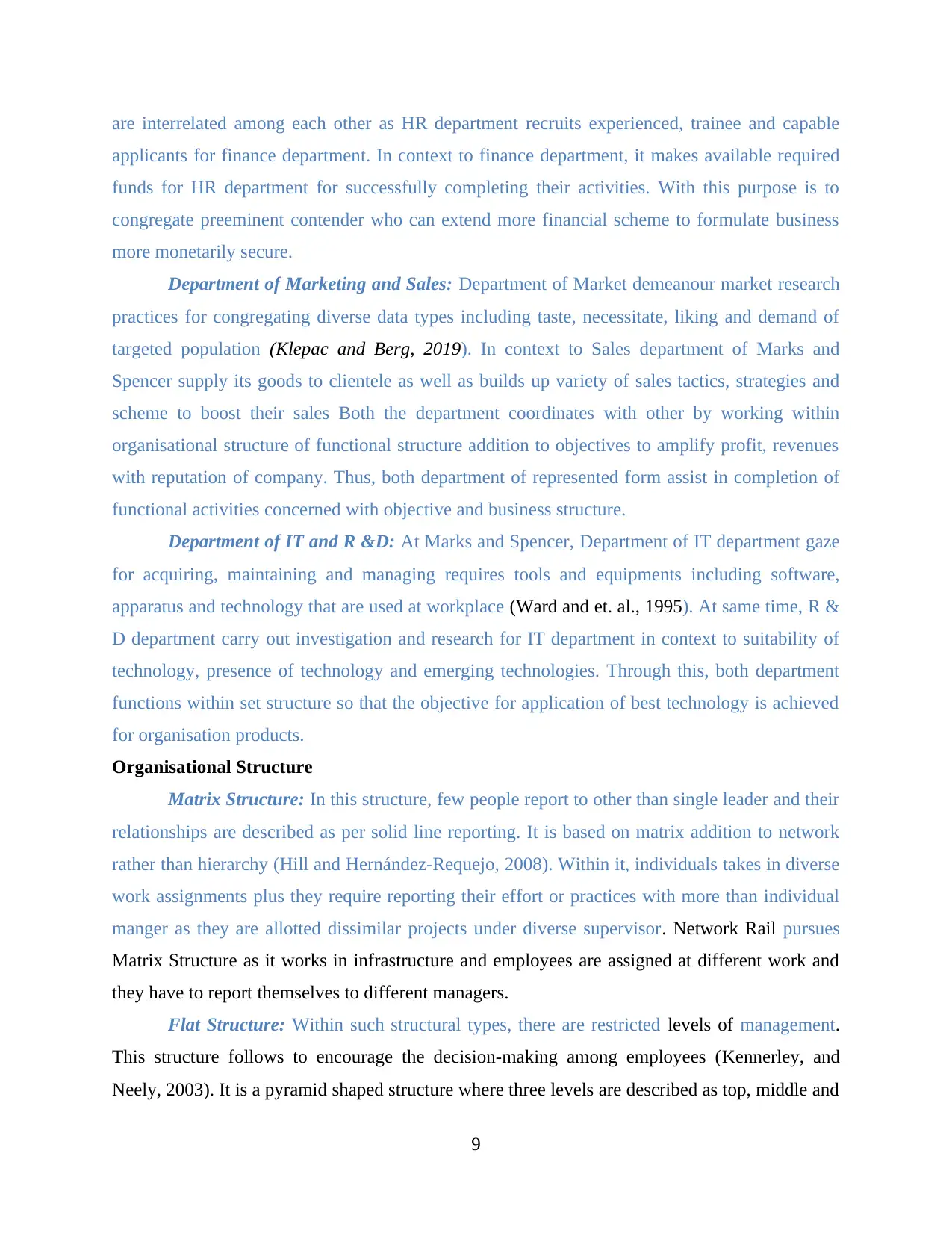
are interrelated among each other as HR department recruits experienced, trainee and capable
applicants for finance department. In context to finance department, it makes available required
funds for HR department for successfully completing their activities. With this purpose is to
congregate preeminent contender who can extend more financial scheme to formulate business
more monetarily secure.
Department of Marketing and Sales: Department of Market demeanour market research
practices for congregating diverse data types including taste, necessitate, liking and demand of
targeted population (Klepac and Berg, 2019). In context to Sales department of Marks and
Spencer supply its goods to clientele as well as builds up variety of sales tactics, strategies and
scheme to boost their sales Both the department coordinates with other by working within
organisational structure of functional structure addition to objectives to amplify profit, revenues
with reputation of company. Thus, both department of represented form assist in completion of
functional activities concerned with objective and business structure.
Department of IT and R &D: At Marks and Spencer, Department of IT department gaze
for acquiring, maintaining and managing requires tools and equipments including software,
apparatus and technology that are used at workplace (Ward and et. al., 1995). At same time, R &
D department carry out investigation and research for IT department in context to suitability of
technology, presence of technology and emerging technologies. Through this, both department
functions within set structure so that the objective for application of best technology is achieved
for organisation products.
Organisational Structure
Matrix Structure: In this structure, few people report to other than single leader and their
relationships are described as per solid line reporting. It is based on matrix addition to network
rather than hierarchy (Hill and Hernández-Requejo, 2008). Within it, individuals takes in diverse
work assignments plus they require reporting their effort or practices with more than individual
manger as they are allotted dissimilar projects under diverse supervisor. Network Rail pursues
Matrix Structure as it works in infrastructure and employees are assigned at different work and
they have to report themselves to different managers.
Flat Structure: Within such structural types, there are restricted levels of management.
This structure follows to encourage the decision-making among employees (Kennerley, and
Neely, 2003). It is a pyramid shaped structure where three levels are described as top, middle and
9
applicants for finance department. In context to finance department, it makes available required
funds for HR department for successfully completing their activities. With this purpose is to
congregate preeminent contender who can extend more financial scheme to formulate business
more monetarily secure.
Department of Marketing and Sales: Department of Market demeanour market research
practices for congregating diverse data types including taste, necessitate, liking and demand of
targeted population (Klepac and Berg, 2019). In context to Sales department of Marks and
Spencer supply its goods to clientele as well as builds up variety of sales tactics, strategies and
scheme to boost their sales Both the department coordinates with other by working within
organisational structure of functional structure addition to objectives to amplify profit, revenues
with reputation of company. Thus, both department of represented form assist in completion of
functional activities concerned with objective and business structure.
Department of IT and R &D: At Marks and Spencer, Department of IT department gaze
for acquiring, maintaining and managing requires tools and equipments including software,
apparatus and technology that are used at workplace (Ward and et. al., 1995). At same time, R &
D department carry out investigation and research for IT department in context to suitability of
technology, presence of technology and emerging technologies. Through this, both department
functions within set structure so that the objective for application of best technology is achieved
for organisation products.
Organisational Structure
Matrix Structure: In this structure, few people report to other than single leader and their
relationships are described as per solid line reporting. It is based on matrix addition to network
rather than hierarchy (Hill and Hernández-Requejo, 2008). Within it, individuals takes in diverse
work assignments plus they require reporting their effort or practices with more than individual
manger as they are allotted dissimilar projects under diverse supervisor. Network Rail pursues
Matrix Structure as it works in infrastructure and employees are assigned at different work and
they have to report themselves to different managers.
Flat Structure: Within such structural types, there are restricted levels of management.
This structure follows to encourage the decision-making among employees (Kennerley, and
Neely, 2003). It is a pyramid shaped structure where three levels are described as top, middle and
9
⊘ This is a preview!⊘
Do you want full access?
Subscribe today to unlock all pages.

Trusted by 1+ million students worldwide
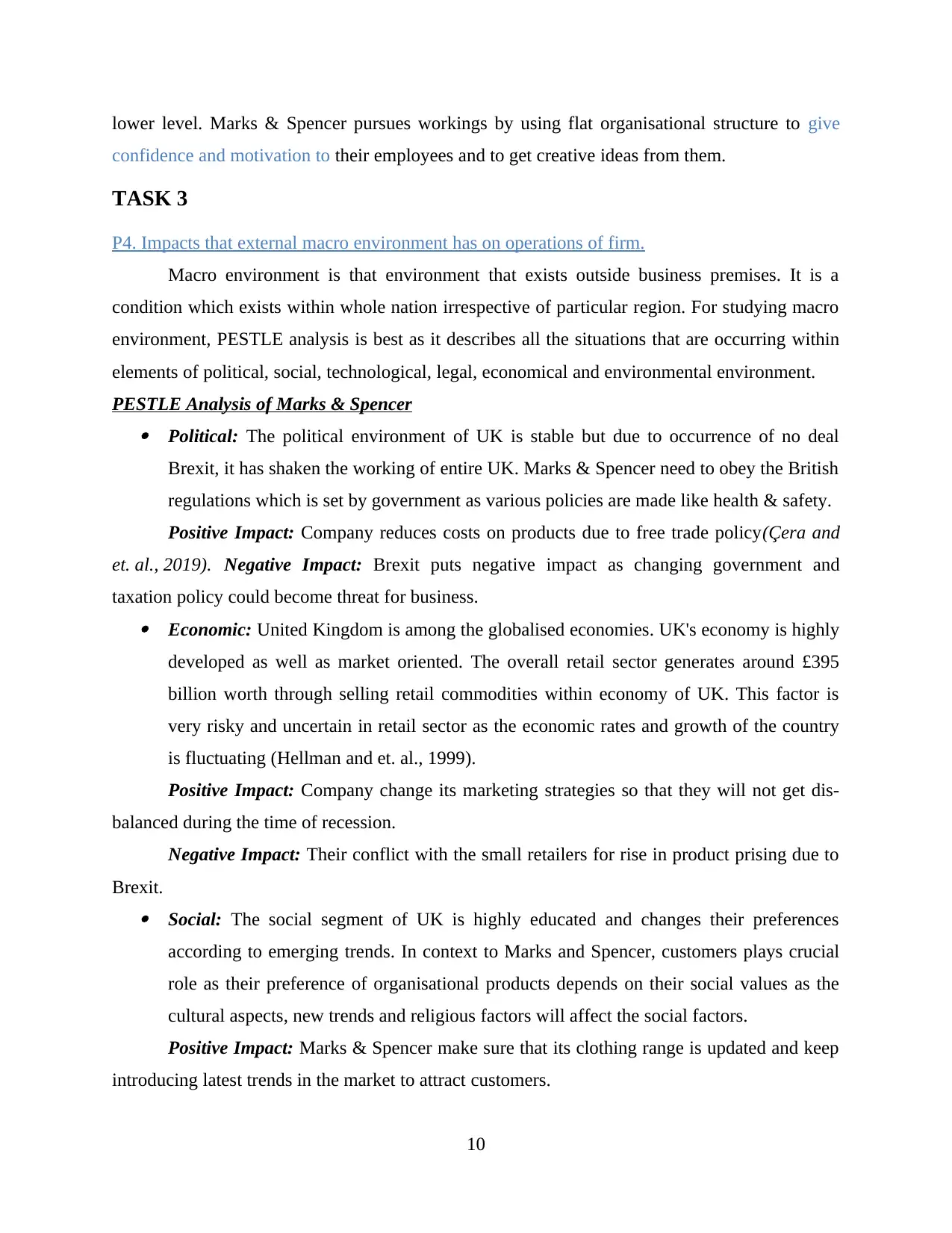
lower level. Marks & Spencer pursues workings by using flat organisational structure to give
confidence and motivation to their employees and to get creative ideas from them.
TASK 3
P4. Impacts that external macro environment has on operations of firm.
Macro environment is that environment that exists outside business premises. It is a
condition which exists within whole nation irrespective of particular region. For studying macro
environment, PESTLE analysis is best as it describes all the situations that are occurring within
elements of political, social, technological, legal, economical and environmental environment.
PESTLE Analysis of Marks & Spencer Political: The political environment of UK is stable but due to occurrence of no deal
Brexit, it has shaken the working of entire UK. Marks & Spencer need to obey the British
regulations which is set by government as various policies are made like health & safety.
Positive Impact: Company reduces costs on products due to free trade policy(Çera and
et. al., 2019). Negative Impact: Brexit puts negative impact as changing government and
taxation policy could become threat for business. Economic: United Kingdom is among the globalised economies. UK's economy is highly
developed as well as market oriented. The overall retail sector generates around £395
billion worth through selling retail commodities within economy of UK. This factor is
very risky and uncertain in retail sector as the economic rates and growth of the country
is fluctuating (Hellman and et. al., 1999).
Positive Impact: Company change its marketing strategies so that they will not get dis-
balanced during the time of recession.
Negative Impact: Their conflict with the small retailers for rise in product prising due to
Brexit. Social: The social segment of UK is highly educated and changes their preferences
according to emerging trends. In context to Marks and Spencer, customers plays crucial
role as their preference of organisational products depends on their social values as the
cultural aspects, new trends and religious factors will affect the social factors.
Positive Impact: Marks & Spencer make sure that its clothing range is updated and keep
introducing latest trends in the market to attract customers.
10
confidence and motivation to their employees and to get creative ideas from them.
TASK 3
P4. Impacts that external macro environment has on operations of firm.
Macro environment is that environment that exists outside business premises. It is a
condition which exists within whole nation irrespective of particular region. For studying macro
environment, PESTLE analysis is best as it describes all the situations that are occurring within
elements of political, social, technological, legal, economical and environmental environment.
PESTLE Analysis of Marks & Spencer Political: The political environment of UK is stable but due to occurrence of no deal
Brexit, it has shaken the working of entire UK. Marks & Spencer need to obey the British
regulations which is set by government as various policies are made like health & safety.
Positive Impact: Company reduces costs on products due to free trade policy(Çera and
et. al., 2019). Negative Impact: Brexit puts negative impact as changing government and
taxation policy could become threat for business. Economic: United Kingdom is among the globalised economies. UK's economy is highly
developed as well as market oriented. The overall retail sector generates around £395
billion worth through selling retail commodities within economy of UK. This factor is
very risky and uncertain in retail sector as the economic rates and growth of the country
is fluctuating (Hellman and et. al., 1999).
Positive Impact: Company change its marketing strategies so that they will not get dis-
balanced during the time of recession.
Negative Impact: Their conflict with the small retailers for rise in product prising due to
Brexit. Social: The social segment of UK is highly educated and changes their preferences
according to emerging trends. In context to Marks and Spencer, customers plays crucial
role as their preference of organisational products depends on their social values as the
cultural aspects, new trends and religious factors will affect the social factors.
Positive Impact: Marks & Spencer make sure that its clothing range is updated and keep
introducing latest trends in the market to attract customers.
10
Paraphrase This Document
Need a fresh take? Get an instant paraphrase of this document with our AI Paraphraser
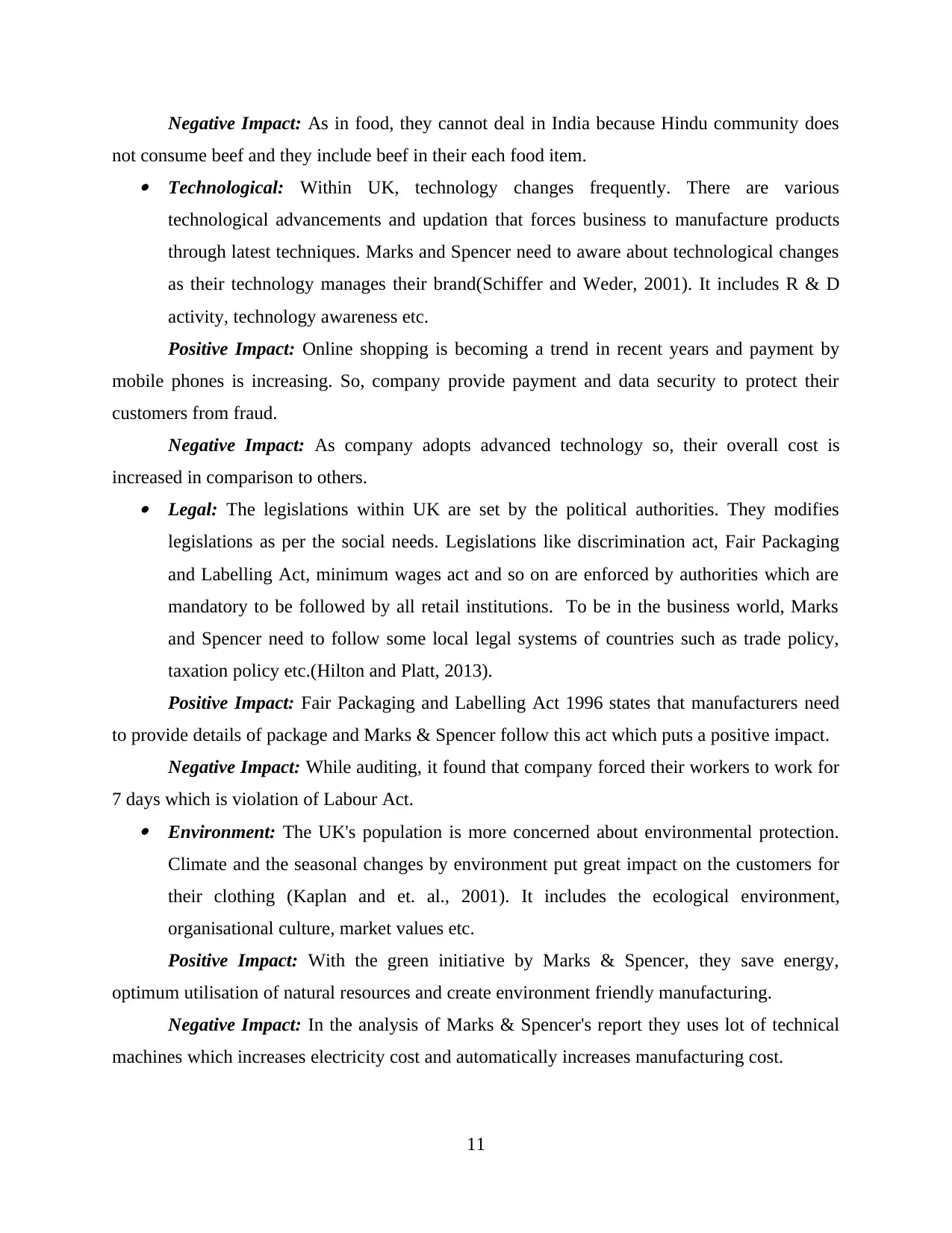
Negative Impact: As in food, they cannot deal in India because Hindu community does
not consume beef and they include beef in their each food item. Technological: Within UK, technology changes frequently. There are various
technological advancements and updation that forces business to manufacture products
through latest techniques. Marks and Spencer need to aware about technological changes
as their technology manages their brand(Schiffer and Weder, 2001). It includes R & D
activity, technology awareness etc.
Positive Impact: Online shopping is becoming a trend in recent years and payment by
mobile phones is increasing. So, company provide payment and data security to protect their
customers from fraud.
Negative Impact: As company adopts advanced technology so, their overall cost is
increased in comparison to others. Legal: The legislations within UK are set by the political authorities. They modifies
legislations as per the social needs. Legislations like discrimination act, Fair Packaging
and Labelling Act, minimum wages act and so on are enforced by authorities which are
mandatory to be followed by all retail institutions. To be in the business world, Marks
and Spencer need to follow some local legal systems of countries such as trade policy,
taxation policy etc.(Hilton and Platt, 2013).
Positive Impact: Fair Packaging and Labelling Act 1996 states that manufacturers need
to provide details of package and Marks & Spencer follow this act which puts a positive impact.
Negative Impact: While auditing, it found that company forced their workers to work for
7 days which is violation of Labour Act. Environment: The UK's population is more concerned about environmental protection.
Climate and the seasonal changes by environment put great impact on the customers for
their clothing (Kaplan and et. al., 2001). It includes the ecological environment,
organisational culture, market values etc.
Positive Impact: With the green initiative by Marks & Spencer, they save energy,
optimum utilisation of natural resources and create environment friendly manufacturing.
Negative Impact: In the analysis of Marks & Spencer's report they uses lot of technical
machines which increases electricity cost and automatically increases manufacturing cost.
11
not consume beef and they include beef in their each food item. Technological: Within UK, technology changes frequently. There are various
technological advancements and updation that forces business to manufacture products
through latest techniques. Marks and Spencer need to aware about technological changes
as their technology manages their brand(Schiffer and Weder, 2001). It includes R & D
activity, technology awareness etc.
Positive Impact: Online shopping is becoming a trend in recent years and payment by
mobile phones is increasing. So, company provide payment and data security to protect their
customers from fraud.
Negative Impact: As company adopts advanced technology so, their overall cost is
increased in comparison to others. Legal: The legislations within UK are set by the political authorities. They modifies
legislations as per the social needs. Legislations like discrimination act, Fair Packaging
and Labelling Act, minimum wages act and so on are enforced by authorities which are
mandatory to be followed by all retail institutions. To be in the business world, Marks
and Spencer need to follow some local legal systems of countries such as trade policy,
taxation policy etc.(Hilton and Platt, 2013).
Positive Impact: Fair Packaging and Labelling Act 1996 states that manufacturers need
to provide details of package and Marks & Spencer follow this act which puts a positive impact.
Negative Impact: While auditing, it found that company forced their workers to work for
7 days which is violation of Labour Act. Environment: The UK's population is more concerned about environmental protection.
Climate and the seasonal changes by environment put great impact on the customers for
their clothing (Kaplan and et. al., 2001). It includes the ecological environment,
organisational culture, market values etc.
Positive Impact: With the green initiative by Marks & Spencer, they save energy,
optimum utilisation of natural resources and create environment friendly manufacturing.
Negative Impact: In the analysis of Marks & Spencer's report they uses lot of technical
machines which increases electricity cost and automatically increases manufacturing cost.
11
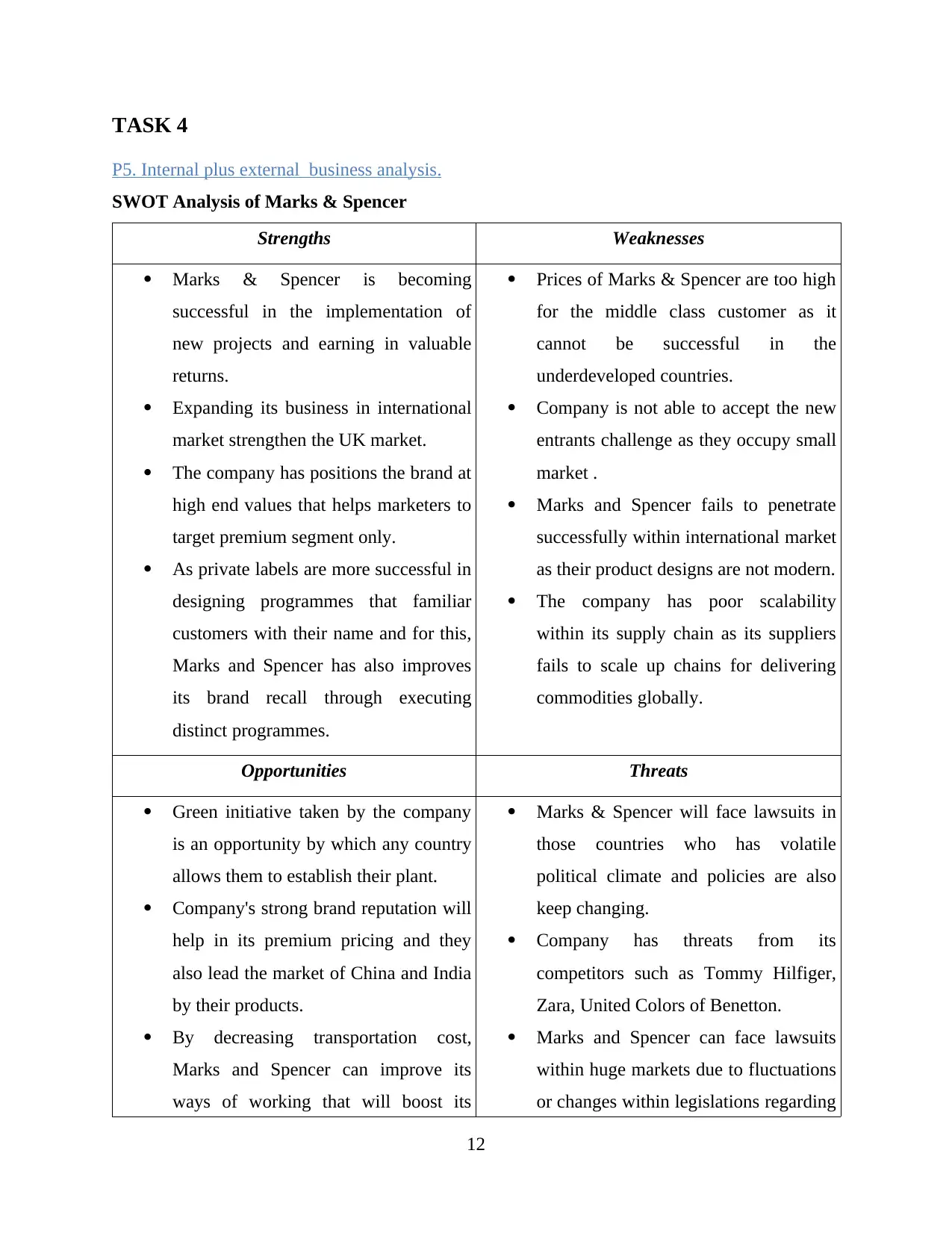
TASK 4
P5. Internal plus external business analysis.
SWOT Analysis of Marks & Spencer
Strengths Weaknesses
Marks & Spencer is becoming
successful in the implementation of
new projects and earning in valuable
returns.
Expanding its business in international
market strengthen the UK market.
The company has positions the brand at
high end values that helps marketers to
target premium segment only.
As private labels are more successful in
designing programmes that familiar
customers with their name and for this,
Marks and Spencer has also improves
its brand recall through executing
distinct programmes.
Prices of Marks & Spencer are too high
for the middle class customer as it
cannot be successful in the
underdeveloped countries.
Company is not able to accept the new
entrants challenge as they occupy small
market .
Marks and Spencer fails to penetrate
successfully within international market
as their product designs are not modern.
The company has poor scalability
within its supply chain as its suppliers
fails to scale up chains for delivering
commodities globally.
Opportunities Threats
Green initiative taken by the company
is an opportunity by which any country
allows them to establish their plant.
Company's strong brand reputation will
help in its premium pricing and they
also lead the market of China and India
by their products.
By decreasing transportation cost,
Marks and Spencer can improve its
ways of working that will boost its
Marks & Spencer will face lawsuits in
those countries who has volatile
political climate and policies are also
keep changing.
Company has threats from its
competitors such as Tommy Hilfiger,
Zara, United Colors of Benetton.
Marks and Spencer can face lawsuits
within huge markets due to fluctuations
or changes within legislations regarding
12
P5. Internal plus external business analysis.
SWOT Analysis of Marks & Spencer
Strengths Weaknesses
Marks & Spencer is becoming
successful in the implementation of
new projects and earning in valuable
returns.
Expanding its business in international
market strengthen the UK market.
The company has positions the brand at
high end values that helps marketers to
target premium segment only.
As private labels are more successful in
designing programmes that familiar
customers with their name and for this,
Marks and Spencer has also improves
its brand recall through executing
distinct programmes.
Prices of Marks & Spencer are too high
for the middle class customer as it
cannot be successful in the
underdeveloped countries.
Company is not able to accept the new
entrants challenge as they occupy small
market .
Marks and Spencer fails to penetrate
successfully within international market
as their product designs are not modern.
The company has poor scalability
within its supply chain as its suppliers
fails to scale up chains for delivering
commodities globally.
Opportunities Threats
Green initiative taken by the company
is an opportunity by which any country
allows them to establish their plant.
Company's strong brand reputation will
help in its premium pricing and they
also lead the market of China and India
by their products.
By decreasing transportation cost,
Marks and Spencer can improve its
ways of working that will boost its
Marks & Spencer will face lawsuits in
those countries who has volatile
political climate and policies are also
keep changing.
Company has threats from its
competitors such as Tommy Hilfiger,
Zara, United Colors of Benetton.
Marks and Spencer can face lawsuits
within huge markets due to fluctuations
or changes within legislations regarding
12
⊘ This is a preview!⊘
Do you want full access?
Subscribe today to unlock all pages.

Trusted by 1+ million students worldwide
1 out of 17
Related Documents
Your All-in-One AI-Powered Toolkit for Academic Success.
+13062052269
info@desklib.com
Available 24*7 on WhatsApp / Email
![[object Object]](/_next/static/media/star-bottom.7253800d.svg)
Unlock your academic potential
Copyright © 2020–2025 A2Z Services. All Rights Reserved. Developed and managed by ZUCOL.





